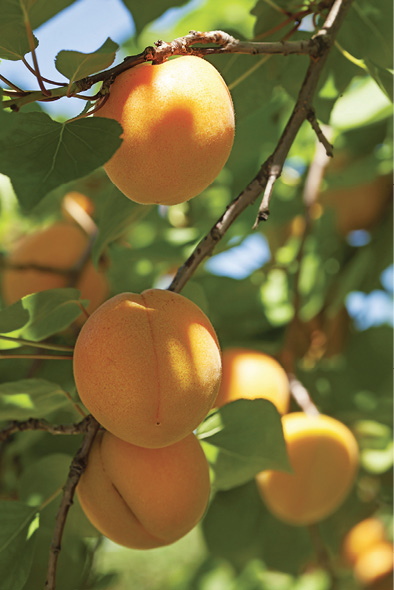Circular 701
Shengrui Yao
College of Agricultural, Consumer and Environmental Sciences, New Mexico State University
Author: Professor/Extension Fruit Specialist, Department of Extension Plant Sciences, New Mexico State University. (Print Friendly PDF)
Late frosts are the number one issue challenging fruit production in central and northern New Mexico. Fruit crops bloom in March for apricots, late March to April for peaches, and early to mid-April for apples; bloom dates vary slightly from year to year at NMSU’s Sustainable Agriculture Science Center at Alcalde. Fruit growers and home gardeners in northern New Mexico have to wait until mid-May each year to learn whether they have a crop or not.
(Photo of apricot fruit on tree branches by © Elena Schweitzer | Dreamstime.com
Types of Freezes
Based on the atmospheric conditions, there are three general types of freezing
conditions.
Advection freeze: A freeze that occurs when a large, cold, dry air mass moves into an area with strong winds. Typically, this is arctic weather from Canada or the West Coast that affects entire regions or states. Under this condition, specific site locations and/or management systems provide little benefit.
Radiation freeze: A freeze that occurs when a local cold air mass settles in an area with little or no wind or clouds. Radiation freezes are common in New Mexico, especially in the valleys of northern New Mexico. On clear nights, cold air drains down into adjacent valleys, resulting in a freeze event. For a radiation freeze, site selection and management practices can minimize damage and benefit plants.
Advection-radiation freeze: This has the characteristics of both freeze types. Of the three types, it is the most damaging.
Critical Temperatures for Frost Damage
The flower development chart of apricot, peach/nectarine, and apple in Figure 1 can be used to guide frost management practices based on forecasted temperatures. For example, if forecasted low temperatures will reach the 10% damage threshold, you may or may not need any action. Some bud/flower damage may occur, and this is a case of “mother nature” helping you thin and possibly improve your fruit crop. But if temperatures will drop into the 50% to 90% damage threshold range, actions are needed to minimize damage and hopefully save your crop.
| APPLE |  |
|||||||
| Silver Tip | Green Tip | Half-Inch Green | Tight Cluster | First Pink (Pink) |
Full Pink |
First Bloom (King Bloom) | Full Bloom and Post-bloom | |
| 10% | 15 | 18 | 23 | 27 | 28 | 28 | 28 | 28 |
| 90% | 2 | 10 | 15 | 21 | 24 | 25 | 25 | 25 |
| PEAR |  |
|||||||
| Swollen Bud (Scale Separation) | Bud Burst (Blossom Buds Exposed) | Green Cluster (Tight Cluster) | White Bud (First White, Popcorn) | Full White | First Bloom (King Blossom) | Full Bloom | Petal Fall (Post-bloom) | |
| 10% | 15 | 20 | 24 | 25 | 26 | 27 | 28 | 28 |
| 90% | 0 | 6 | 15 | 19 | 22 | 23 | 24 | 24 |
| APRICOT |  |
||||||
|
First Swell |
Tip Separation (Swollen Bud) | First White | First Bloom | Full Bloom | In the Shuck (Petal Fall) |
Shuck Split |
|
| 10% | 15 | 20 | 24 | 25 | 27 | 27 | 28 |
| 90% | -- | 0 | 14 | 19 | 22 | 24 | 25 |
| CHERRY |  |
||||||
| Sweet | Swollen Bud (First Swell) |
Bud Burst (Green Tip) | Tight Cluster | White Bud (First White, Popcorn) | First Bloom | Full Bloom | Post-bloom |
| 10% | 17 | 25 | 26 | 27 | 28 | 28 | 28 |
| 90% | 5 | 14 | 17 | 24 | 25 | 25 | 25 |
| Tart | |||||||
| 10% | 15 | 26 | 26 | 28 | 28 | 28 | |
| 90% | 0 | 22 | 24 | 24 | 24 | 24 | |
| PEACH / NECTARINE |  |
||||||
| Swollen bud (First Swell) | Calyx Green |
Quarter-inch Green (Calyx Red) |
Pink (First Pink) | First Bloom | Full Bloom | Post-bloom | |
| 10% | 18 | 21 | 23 | 25 | 26 | 27 | 28 |
| 90% | 1 | 5 | 9 | 15 | 21 | 24 | 25 |
| PLUM | Swollen Bud | Side White | Green Tip | Tight Cluster | First White | First Bloom | Full Bloom | Post-bloom |
| 10% | 14 | 17 | 20 | 24 | 26 | 27 | 28 | 28 |
| 90% | 0 | 3 | 7 | 16 | 22 | 23 | 23 | 23 |
Figure 1. Critical temperatures at different development stages of several fruit species. (Source: Murray [2020] and Washington State University Extension [2021]. Used with permission.)
Weather forecast information is critical in frost management. Growers should regularly compare temperatures at their own site with local forecasts, and use forecasts that are most similar to manage their site. With some GPS-based weather channels or smartphone apps, growers can get very accurate and precise temperature forecasts. However, it is strongly recommended that commercial growers have an on-site low temperature alarm system to warn when it is necessary to begin frost protection actions.
Frost Damage Symptoms on Fruit Trees
Flower buds are less hardy than vegetative buds, and flowers in bloom and fruitlets are more vulnerable than flower buds in the “tight bud” or “balloon” stage. As flower buds develop, their hardiness decreases (Figure 1). Within a flower, the pistil (female) is the most sensitive part, followed by stamens (male), then petals. A razor blade and magnifying glass can be used to check the buds or flowers for frost damage. The length of a damaged pistil can be used as a rough indicator of when the freeze happened. If the damaged pistils are 2 mm (0.08 inch) or less, most of time they were damaged by winter freezes; if pistils are elongated but relatively short, it means they were damaged earlier; and if the pistils are almost the same length as heathy flowers, it means they were damaged recently. Some years, when the small fruits are 1–1.25 cm (3/8–1/2 inch) in diameter and are damaged by frost, they will display a shrunken surface and contain brown seeds. Such damaged fruit will fall off after the frost event.
Figures 2 through 5 show frost damage symptoms on apple, peach, cherry, and plum, respectively. Growers and home gardeners can use a razor blade and magnifying glass to check the amount of frost damage.

Figure 2. Top: Apple central flower damage with healthy side flowers, and front and back of damaged leaf in 2010. Bottom: Apple frost ring and different levels of frost damage on the fruit surface in 2010. (Photo by Shengrui Yao, NMSU.)

Figure 3. Peach flower bud winter damage (left photo; healthy bud on the left and damaged bud on the right) and frost damage (middle and right photos). The relative pistil length reveals the relative date of the frosts or winter damage. (Photo by Shengrui Yao, NMSU.)

Figure 4. Cherry flower buds and flower damage. Healthy ‘Montmorency’ bud (A), damaged stamens and pistils in buds (B), and healthy and damaged pistils (C and D) of different lengths/stages. Green circles indicate healthy pistils, red circles indicate frosted pistils. (Photo by Shengrui Yao, NMSU.)

Figure 5. Winter damage in plum flower buds (left photo), healthy and frost-damaged flower pistils (middle photo), and healthy and frosted fruitlets (right photo). Green circles indicate healthy buds/pistils, red circles indicate frosted buds/pistils. (Photo by Shengrui Yao, NMSU.)
Frost Management
Frosts can be managed actively or passively. For example, growers can actively select a favorable orchard site to avoid damage from late frosts. Such a site would be at least 50 feet above the bottom of the valley, on a 6- to 8-degree slope for good air drainage, or adjacent to a large body of water that can moderate temperature changes. However, the ability to choose an orchard site location is often limited by budget and/or availability of irrigation water.
There are some late frost management techniques that can be used with variable results across most sites.
1. Wind machines: Suitable for orchard settings in case of radiation frosts. Can increase the orchard temperature 2 to 4°F. Limited efficacy when temperatures drop to 22°F and below. Wind machines will be effective only when there is a strong inversion layer so that the air 20 to 30 feet above the orchard is significantly warmer than air temperatures within the orchard.
2. Heaters/smudge pots: Portable and suitable for backyard trees, orchards, or in high tunnels. A minimum number of pots is required to be effective (depending on temperature, orchard setting, and tree density), and fuel costs are a consideration.
3. Helicopters: Suitable for large plantings, with limited usage in New Mexico. Also requires a strong inversion layer.
4. Overhead sprinklers: Work well for frost protection, but need a continuous water supply and correct nozzle sizing/pressure for effective water application rates. If there is a high frost frequency, soil nutrient leaching should also be considered.
5. Under-canopy sprinklers: Provide limited protection. Can be used together with wind machines or combined with regular irrigation system.
6. High tunnels: Provide limited protection. If late frosts occur frequently with <25°F temperatures, additional heating is needed inside the high tunnel to protect the flowers or fruitlets.
7. Row covers/light bulbs. Provide limited protection. Suitable for home gardeners. Row covers work on low-status crops like berries. Christmas lights can be used, and bulbs should be 7-watt incandescent bulbs, not LEDs. Home gardeners with a few fruit trees can try them with a tarp/plastic cover over the trees.
8. Others: Barbeque grills/stoves can also help when it is close to the end of the late frost season if home gardeners hope to save one or two fruit trees in the backyard. Put the grill/stove on the low setting when temperatures become critically low, and let it run overnight with the tree covered with plastic or tarps, which may save the fruit of a couple of fruit trees in a backyard.
9. There are sprayable compounds being developed to delay bloom. These are still in the trial stage. Hopefully, some commercial products will be registered for use soon.
References
Murray, M. 2020. Critical temperatures for frost damage on fruit trees [IPM-012-11]. Logan, UT: Utah State University Extension and Utah State Plant Diagnostic Laboratory. Available at https://extension.usu.edu/productionhort/files-ou/CriticalTemperaturesFrostDamageFruitTrees.pdf
Washington State University Extension. 2021. 2021 crop production guide for tree fruits in Washington: Critical temperatures [EB0419]. Pullman, WA: Author. Available at http://cpg.treefruit.wsu.edu/critical-temperatures/
For Further Reading
H-308: Why Fruit Trees Fail to Bear
https://pubs.nmsu.edu/_h/H308/
H-310: Fruits and Nuts for New Mexico Orchards
https://pubs.nmsu.edu/_h/H310/
H-327: Pruning the Home Orchard
https://pubs.nmsu.edu/_h/H327/

Shengrui Yao is Professor and Extension Fruit Specialist at New Mexico State University's Sustainable Agriculture Science Center at Alcalde. She earned her Ph.D. in pomology/horticulture at Cornell University. Her research and Extension work focus on tree fruit and small fruit production, conventional and organic production, and orchard floor and soil fertility management.
To find more resources for your business, home, or family, visit the College of Agricultural, Consumer and Environmental Sciences on the World Wide Web at pubs.nmsu.edu.
Contents of publications may be freely reproduced, with an appropriate citation, for educational purposes. All other rights reserved. For permission to use publications for other purposes, contact pubs@nmsu.edu or the authors listed on the publication.
New Mexico State University is an equal opportunity/affirmative action employer and educator. NMSU and the U.S. Department of Agriculture cooperating.
November 2021 Las Cruces, NM



